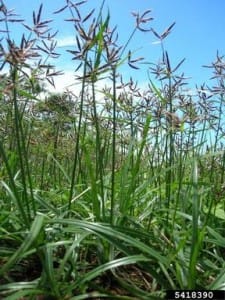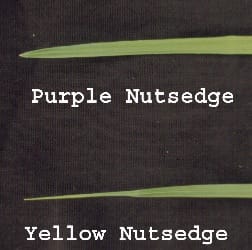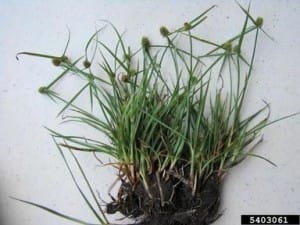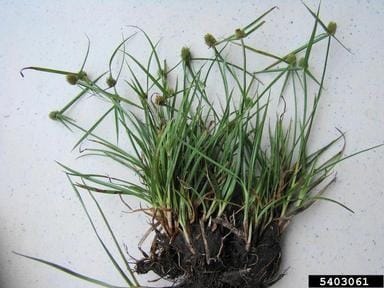Information supplied by Patrick McCullough, UGA Extension Weed Scientist and the publication Weed Control in Home Lawns

Hot and humid weather contributes to certain weeds in lawns – particularly sedges! Sedges come in many types – nutsedges, annual and perennial sedges and kyllinga. Identification of the sedge is the first step (though exact id of sedges can be difficult!) See this site if you need help with identification. Another great resource for weed identification is the UGA publication Weeds of Southern Turf.
Once you identify the sedge; select control methods based on this identification and the weeds biology – annual/perennial, warm/cool season, etc.
Post-emergence herbicide controls for sedges
-

Leaf tips of Yellow and Purple Nutsedge. Notice the differences in leaf tips. Purple Nutsedge has a keel shape, and yellow nutsedge is pinched. Mark Czarnota flazasulfuron – Katana (25 WG) is a selective herbicide for control of annual and perennial grasses, sedges and broadleaf weeds in bermudagrass, zoysiagrass and certain other warm season grasses. Flazasulfuron has postemergence and some preemergence activity and may be used on golf courses (fairways, roughs and tees) and the following non-residential turf areas: industrial parks, tank farms, sod farms, seed farms, cemeteries, professionally managed college and professional sport fields and commercial lawns for control of cool season grasses and weeds from tolerant grasses. The maximum yearly application rate is 9.0 oz. per acres. Use only on labeled turfgrasses or severe injury may result. Do not apply to newly seeded, sodded or sprigged turfgrass until well established. Allow at least 2 weeks from the last application to the time of overseeding when applied at 1.5 oz per acre. Allow 4 weeks for rates above 1.5 oz
- halosulfuron – Sedgehammer (75DF) is a selective herbicide for postemergence control of sedges such as purple and yellow nutsedge in established lawns. Sedgehammer may be applied to most major warm- and cool-season turfgrasses. For best results, apply 2/3 to 1 1/3 ounces of product per acre after nutsedge has reached the three to eight leaf stage of growth. A second treatment may be required six to 10 weeks after the initial treatment. Use the lower rate in light infestations and the higher rate in heavy infestations. No more than four applications can be made with the total use rate not exceeding 5 1/3 ounces of product per acre per season. Use 0.25% v/v of a nonionic surfactant (1 quart per 100 gallons of spray solution) for broadcast applications. Use only high quality nonionic surfactants that contain at least 80% active ingredient.
- imazaquin – Image (1.5 lbs/gallon) is labeled for use only in established bermudagrass, centipedegrass, St. Augustinegrass and zoysiagrass. All other turfgrasses can be severely injured by imazaquin. This herbicide is primarily used for the postemergence control of annual sedges, yellow nutsedge, purple nutsedge and wild garlic. Imazaquin will also control numerous winter annual weeds and sandbur.
-

Green kyllinga – Rebekah D. Wallace, University of Georgia, Bugwood.org sulfentrazone — Dismiss (4 lbs/gallon) is a postemergence herbicide labeled for most major warm- and cool-season turfgrasses. Use lower rates on cool-season turfgrass than warm-season turf due to injury concerns. Dismiss controls annual and perennial sedges, broadleaf weeds and suppresses goosegrass.Dismiss may be used on seeded, sodded or sprigged turfgrasses that are well established. Applications of Dismiss can be initiated following the second mowing provided the turfgrass has developed into a uniform stand with a good root system. Turfgrass injury could result from application of this product on turfgrass that is not well established or has been weakened by stresses such as unfavorable weather conditions, disease, chemical or mechanical damage. Dismiss may cause temporary discoloration to St. Augustinegrass and zoysiagrass.
- Sulfentrazone is also found in the combination products Surge and Q4. Surge contains sulfentrazone, 2,4-D, dicamba and MCPP and effectively controls annual, biennial and perennial broadleaf weeds. Surge may be applied to dormant bermudagrass, zoysiagrass and bahiagrass but do not apply during spring green-up or in the fall during the transition period between active growth and dormancy. Q4 contains sulfenetrazone, quinclorac, 2,4-D and dicamba for broadleaf weed, crabgrass and nutsedge control. For best results, add 0.25 lb of active ingredient per acre of quinclorac (Drive) and 0.06 to 0.19 lb of active ingredient per acre of sulfentrazone (Dismiss) for crabgrass and nutsedge control, respectively.
- sulfosulfuron — Certainty (75DF) is labeled for bermudagrass, St. Augustinegrass, zoysiagrass and centipedegrass. Certainty selectively controls sedges, kyllingas and tall fescue. A second application of 0.75 to 1.25 ounces per acre may be made four to 10 weeks after initial treatment, if needed. Some chlorosis or stunting of the desirable turf may occur following application. Use of a nonionic surfactant is required. Certainty suppresses annual bluegrass and controls or suppresses roughstalk bluegrass.
- trifloxysulfuron-sodium – Monument (75 DG) is labeled for established bermudagrass and zoysiagrass. Monument is not recommended for use on other turfgrass species. Controls nutsedge(s), green kyllinga, annual bluegrass, tall fescue, torpedograss and certain broadleaf weeds. Not labeled for use on home lawns. Add a nonionic surfactant at 0.25 to 0.5% v/v to the spray mix. Avoid mowing for 1 to 2 days before and after application. For nutsedge repeat the application at 4 to 6 weeks if regrowth is observed. DO NOT overseed bermudagrass with cool-season turfgrasses for 3 weeks after application.
Cultural practices to control sedges
The first line of defense against weeds is to follow cultural practices that promote vigorous turfgrass growth and development. Weeds do not easily invade turfgrasses that are properly fertilized and watered and that are mowed at the correct height and frequency. Weeds appear primarily in bare or thin areas of the turfgrass, which may be due in part to one or more of the following:
- Use of non-adapted turfgrasses.
- Improper fertilization (too much or too little, wrong application date or N-P-K ratio).
- Improper watering (too much or too little).
- Improper mowing procedures (cutting height is too low or too high, or the turfgrass is not mowed at correct time intervals).
- Failure to control diseases and insects.
- Excessive amounts of thatch.
Visit www.GeorgiaTurf.com for additional information on turfgrass maintenance practices. The impact of proper cultural practices on a lawn weed control program cannot be overemphasized. Properly maintained turfgrasses are more competitive with weeds than turfgrasses that do not receive good cultural practices. The use of herbicides without following approved cultural practices will not result in a high quality, weed-free lawn.
Read the entire publication from which most of this information comes Weed Control in Home Lawns
